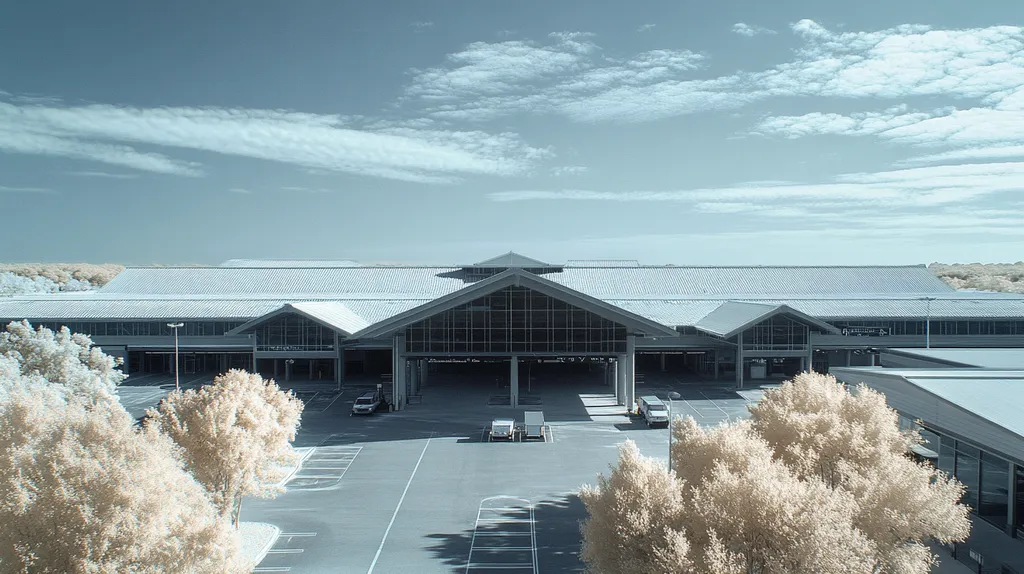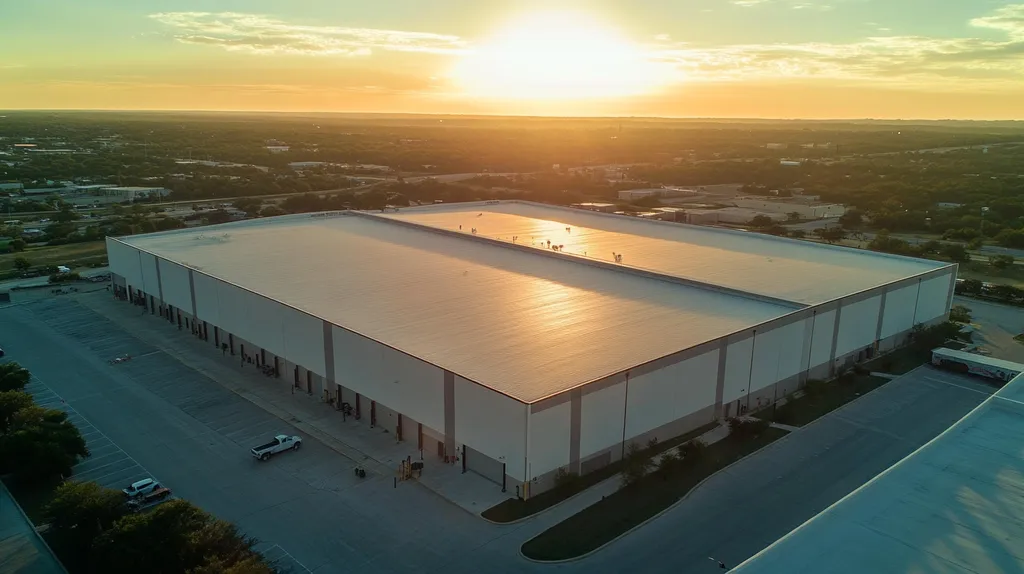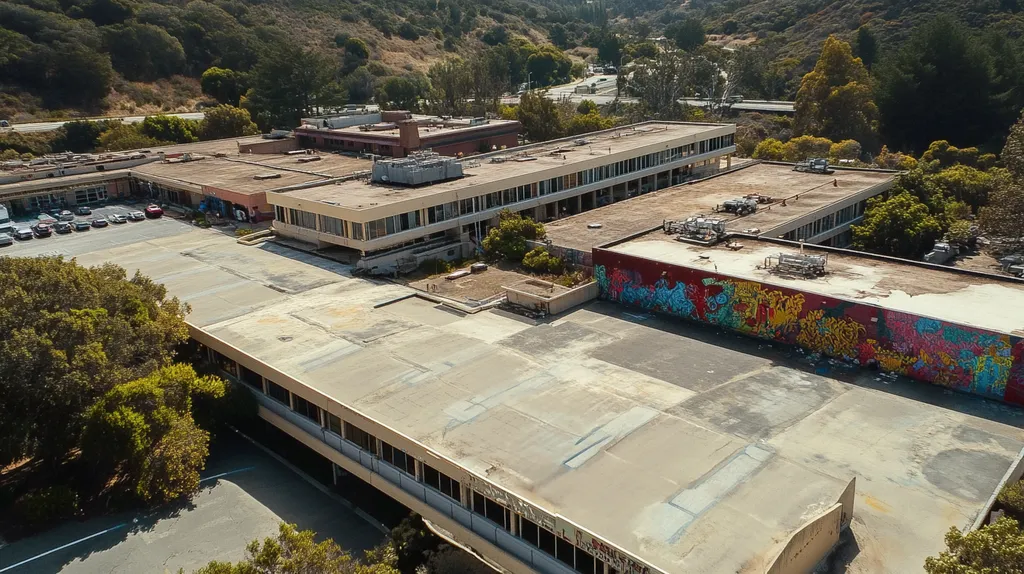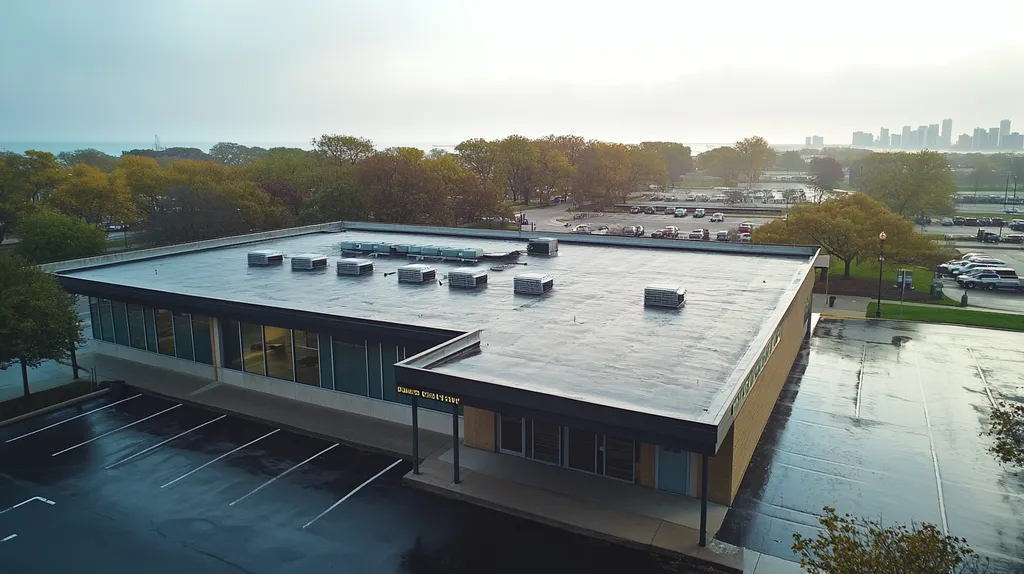Rising energy costs and increasing environmental regulations have made commercial roof performance a critical concern, with studies showing that inefficient roofing systems can waste up to 30% of a building’s energy.
For property owners and facility managers, enhancing roof insulation represents one of the most impactful ways to improve building efficiency and reduce operational expenses.
This comprehensive guide examines the essential factors for optimizing roof insulation, from material selection and installation quality to financial considerations and compliance requirements, providing actionable solutions for high-performance building operations.
SECTION 1: PERFORMANCE FACTORS
The necessity of enhancing energy efficiency in existing commercial roofs is more critical than ever. Research shows that poor roofing systems can account for up to 30% of a building’s energy costs. With energy prices on the rise and a growing emphasis on sustainability, property owners must focus on maximizing the performance of their roofs. Key elements contributing to this goal include smart material choices, exceptional insulation quality, and efficient ventilation systems. Familiarity with these factors is vital for achieving meaningful energy improvements.
Roof Material Selection
Choosing superior roofing materials is essential for optimizing energy efficiency. Conventional materials may not provide sufficient insulation, resulting in inflated energy usage. For example, single-ply membranes are gaining popularity for their reflective characteristics, which can substantially reduce cooling expenses.
Additionally, cool roofing solutions play a significant role in minimizing heat absorption. Materials with high solar reflectance can lower indoor temperatures, thereby reducing the need for air conditioning. This can offer substantial savings in regions with warmer climates.
Equally important is selecting materials known for their longevity and lower maintenance needs. By reducing replacement costs and minimizing disruptions from repairs, property owners can achieve a more resilient roofing system.
Key Action Items
Insulation Quality and Installation
Insulation serves as a crucial barrier to heat loss and gain, significantly affecting a roof’s energy performance. The effectiveness of a roofing system largely depends on the quality of insulation used. High-performance insulation can dramatically lower energy expenses.
Moreover, proper installation is critical. Gaps and poorly sealed seams can lead to air leaks, diminishing insulation’s capabilities. Research indicates that up to 25% of energy loss can stem from inadequately insulated roofs.
Facilities managers should also focus on the R-value, which indicates insulation’s resistance to heat flow. Higher R-values represent enhanced insulating properties. Selecting materials with suitable R-values for specific climate zones ensures energy efficiency throughout different seasons.
Key Action Items
Ventilation System Efficiency
A well-functioning ventilation system is vital for maintaining a stable internal climate, significantly affecting energy costs. Inefficient ventilation can lead to overheating and an excessive demand for air conditioning during hot months.
Furthermore, effective ventilation contributes to the longevity of roofing materials. Trapped moisture can result in mold growth and faster deterioration. Installing energy-efficient ventilation fans helps maintain optimal air circulation.
Additionally, monitoring systems that keep track of indoor air quality can facilitate timely adjustments. Maintaining ideal air quality not only enhances comfort for occupants but also improves energy usage.
Key Action Items
SECTION 2: FINANCIAL CONSIDERATIONS
Understanding the financial implications of enhancing roof insulation is vital for commercial and industrial property owners. While energy-efficient roofs can deliver significant savings, it’s essential to grasp the initial investment involved. By carefully evaluating costs alongside potential savings, property owners can make informed decisions that benefit both their finances and the environment. This section breaks down initial expenses, long-term energy savings, and maintenance costs, giving a thorough financial perspective.
Initial Investment and Cost-Benefit Analysis
The initial cost of upgrading roof insulation might seem daunting, but the long-term advantages typically outweigh these expenses. Improvements could include upgrading to better materials or applying reflective coatings. A cost-benefit analysis can reveal substantial energy expense savings in the long run.
This analysis should factor in installation costs, materials, and any potential downtime. Choosing the right insulation type—like spray foam or fiberglass—can significantly influence both upfront costs and overall performance.
Moreover, property owners can often take advantage of financial incentives or rebates from government programs, further reducing net expenses. Identifying and quantifying expected energy efficiency gains is essential for prioritizing roofing upgrades that yield the highest return on investment.
Key Action Items
Long-Term Energy Savings and ROI
Investing in better roof insulation can lead to substantial energy savings over time. Studies show that effective insulation reduces heating and cooling costs by 20% to 50%, translating into significant financial returns as these savings accumulate throughout the roof’s lifespan.
To calculate return on investment (ROI), property owners should estimate their energy savings compared to initial costs. For example, if a property spends $20,000 annually on energy, a properly insulated roof could save between $4,000 and $10,000 each year. Over a decade, those savings could total between $40,000 and $100,000.
These projections underscore the importance of long-term planning focused on insulation. Regularly reviewing financial forecasts allows property owners to stay updated about ongoing savings and ROI. Implementing energy-efficient solutions can also increase property value and demand, making the initial expenditures worthwhile.
Key Action Items
Maintenance and Repair Costs
While upgrading roof insulation offers immediate financial advantages, ongoing maintenance costs should also be considered. Improved insulation can extend the lifespan of roofing materials by protecting them from damage caused by temperature fluctuations.
Regular inspections and maintenance are critical for ensuring that insulation performs at its best. Property owners should schedule routine assessments to identify any issues early on, which helps prevent costly repairs and replacements in the future.
Investing in high-quality insulation materials can reduce the frequency and expense of repairs. Nonetheless, even the most efficient systems require some level of upkeep, which should be included in overall budgeting strategies.
Key Action Items
SECTION 3: COMPLIANCE REQUIREMENTS
In today’s world, where energy efficiency is an imperative, grasping compliance requirements is essential for property owners. As energy prices rise and regulations increase, neglecting to meet building codes can lead to severe financial consequences. Buildings account for nearly 40% of energy consumption, underscoring the importance of adhering to energy efficiency standards. This section outlines the key compliance areas that every facility manager must be aware of.
Building Codes and Regulations
Building codes lay down the essential criteria for roofing upgrades, ensuring safety and energy efficiency. Local jurisdictions frequently update these codes to improve performance, often mandating higher insulation levels to reduce heat loss.
Failing to comply with these regulations can result in hefty fines and project delays. Non-compliant roofs may face complications such as permit denials or required modifications, making it crucial for facilities managers to stay informed about local building codes.
Each state has its own set of requirements, necessitating diligent research. Engaging with local building departments can provide clarity on compliance needs. Staying updated with these regulations ensures property owners make informed and efficient investments in roofing solutions.
Key Action Items
Energy Efficiency Standards
Energy efficiency standards are vital in roofing compliance, potentially leading to significant operational cost savings. Regulations, like ASHRAE 90.1, offer guidelines designed to minimize energy use in commercial structures, enhancing overall building efficiency.
For instance, using reflective roofing materials contributes to energy-saving goals by lowering heat absorption, thus cutting cooling costs. These materials are increasingly becoming mandatory in various jurisdictions, highlighting the need for property owners to stay updated on latest benchmarks.
Conducting regular energy audits is crucial to verify compliance with efficiency standards. These assessments reveal areas needing improvement, such as subpar insulation or inefficient HVAC systems, which must be addressed along with roofing upgrades for maximal energy efficiency.
Key Action Items
Environmental Compliance
Environmental compliance is becoming increasingly important in roofing decisions as sustainability efforts gain momentum. Regulations aimed at reducing environmental impact often require the use of materials that meet LEED (Leadership in Energy and Environmental Design) standards.
Implementing sustainable roofing solutions, like green roofs or materials with high recycled content, can help property owners meet these environmental responsibilities. Neglecting these regulations can result in penalties and damage the organization’s reputation in an eco-conscious market.
Furthermore, improper disposal of roofing waste can violate environmental laws. Adopting best practices for waste management—like recycling roofing materials—enhances compliance and demonstrates corporate responsibility.
Key Action Items
SECTION 4: RISK MANAGEMENT
The urgency of enhancing roof insulation performance is paramount in today’s climate of rising energy costs and stringent environmental regulations. Over 30% of energy in commercial buildings is consumed for heating and cooling, making inefficient roofs a significant liability. Effectively managing heat and moisture issues, ensuring structural integrity, and enhancing weather resistance are crucial for mitigating risks. This section provides essential insights for property owners and facility managers to safeguard their investments.
Heat and Moisture Related Issues
Inadequate insulation and ventilation can create an environment where heat and moisture are trapped, fostering mold growth and threatening structural integrity. Such neglect can increase energy consumption by 15-30%. To combat these challenges, property owners need solutions that promote airflow while improving thermal resistance.
One effective strategy is the installation of vapor barriers, which protect roof assemblies from moisture infiltration, thereby minimizing risks of mold and decay. Conducting regular inspections helps catch early signs of trapped moisture, facilitating timely intervention.
The quality of insulation installation is equally important. Techniques like continuous insulation can eliminate thermal bridges and minimize heat loss. Upgrading to more effective insulation materials enhances air retention in both winter and summer.
Key Action Items
Structural Integrity and Durability
Neglecting the structural integrity of roofing systems can expose properties to costly failures. Over time, weather conditions, traffic, and material fatigue can compromise a roof’s structural strength. Strengthening existing materials and employing overlays increases durability and extends service life.
It’s vital to reinforce stress-prone areas, such as roof penetrations, using high-quality and weather-resistant materials. Ensuring compliance with building codes and standards during upgrades is essential for roofs to withstand local climatic challenges.
Conducting load calculations is crucial, as roofs must accommodate the weight of insulation, HVAC units, and potential snow accumulation. Regular assessments of the structural system can identify emerging issues before they escalate into significant problems.
Key Action Items
Weathering and UV Resistance
The adverse effects of weathering and UV exposure can significantly deteriorate roofing materials, leading to increased maintenance needs and energy inefficiencies. Commercial roofs, in particular, face harsh conditions that demand investments in materials resistant to UV damage.
High-performance roofing membranes that reflect UV rays help mitigate heat buildup, increasing energy efficiency and prolonging roof life. Implementing cool roofing systems with reflective surfaces can lower interior temperatures and significantly reduce cooling costs.
Regular maintenance routines should include inspections for common weather damage signs, such as cracking and blistering. Re-coating existing roofs can restore protective layers, optimizing thermal performance, while effective drainage systems prevent water pooling and possible damage.
Key Action Items
SECTION 5: OPERATIONAL PROCEDURES
Implementing effective operational procedures is vital for the performance and longevity of commercial roofs. Regular oversight not only helps catch minor issues but also prevents them from escalating into costly repairs or replacements. Studies show that proactive maintenance can extend a roof’s lifespan by up to 50%. This section will cover the essential elements of regular inspections and maintenance, repair protocols, and comprehensive training for facility personnel.
Regular Inspection and Maintenance
Routine inspections are critical for spotting potential issues before they compromise roof performance. Establishing a defined inspection schedule should involve checks for leaks, membrane integrity, and insulation condition. These assessments should ideally take place at least twice a year and following significant weather events.
By implementing a thorough maintenance plan, problems can be identified early, reducing the risk of severe damage. Facilities managers should document their findings and act on repairs swiftly. This proactive approach not only boosts efficiency but also ensures compliance with industry standards.
Leveraging technology, such as drone inspections, can significantly enhance the monitoring process. These advanced tools provide detailed visual data, equipping managers to make informed decisions regarding their roofing systems.
Key Action Items
Repair and Replacement Protocols
Establishing clear repair and replacement protocols is essential for safeguarding roof integrity. When deficiencies arise during inspections, having a structured approach ensures timely repairs are made. Property owners should prioritize issues based on their potential impact on energy efficiency.
For instance, small leaks should be dealt with immediately, while more extensive repairs may require professional evaluation. Engaging a qualified contractor is important to uphold the quality of repairs and ensure long-term solutions.
In some scenarios, opting for a complete roof replacement could be more financially prudent than ongoing patchwork repairs. Performing a thorough cost-benefit analysis is necessary to weigh all options effectively. Choosing higher-quality materials during major repairs can lead to increased energy efficiency.
Key Action Items
Training for Facility Personnel
Training facility personnel on roofing best practices is vital for achieving and maintaining energy efficiency. Staff should understand the significance of routine maintenance and be equipped to identify early signs of roofing issues. A knowledgeable team acts as the first line of defense against common problems.
Additionally, training should encompass the operation of specialized equipment used during inspections and maintenance. By empowering personnel with this knowledge, response times can be expedited, thereby minimizing risks to energy efficiency.
Holding regular training sessions fosters a culture of safety and awareness surrounding roof management. This investment decreases repair costs while enhancing the overall performance of the building.
Key Action Items
SECTION 5: OPERATIONAL PROCEDURES
Implementing effective operational procedures is essential to maintain and enhance the energy efficiency of commercial roofs. Regular oversight is critical in catching minor issues before they escalate into costly repairs or replacements. Research shows that proactive maintenance can potentially extend a roof’s lifespan by up to 50%. This section highlights the importance of regular inspections and maintenance, well-defined repair protocols, and thorough training for facility personnel.
Regular Inspection and Maintenance
Routine inspections are vital for detecting potential issues that may threaten roof performance. Establishing a clear inspection schedule should involve checks for leaks, membrane integrity, and insulation conditions. These evaluations should occur at least twice a year and after significant weather events.
By adhering to a proactive maintenance plan, problems can be identified early, effectively minimizing the risk of damage. Facility managers should document all findings and address necessary repairs immediately. This diligence not only enhances efficiency but also ensures compliance with industry standards.
Moreover, utilizing advanced technology like drone inspections can significantly improve the monitoring process. Drones provide detailed visual data, empowering managers to make informed decisions about their roofing systems.
Key Action Items
Repair and Replacement Protocols
Establishing effective repair and replacement protocols is crucial for maintaining roof integrity. When deficiencies are discovered during inspections, having a systematic approach ensures timely repairs. Property owners should prioritize issues based on their potential impact on energy efficiency.
For instance, small leaks demand immediate attention, while larger, more complicated repairs may require professional assessment. Engaging qualified contractors to perform repairs is essential to ensure long-lasting solutions.
In certain situations, opting for a complete roof replacement could be more financially sound than recurring patchwork repairs. A thorough cost-benefit analysis is necessary to evaluate all options. Choosing higher-quality materials for replacements can also promote greater energy efficiency.
Key Action Items
Training for Facility Personnel
Training facility personnel on roofing best practices is vital for achieving and maintaining energy efficiency. Staff should be educated on the significance of routine maintenance and how to recognize early signs of roofing issues. A well-informed team serves as the first line of defense against common problems.
Additionally, training should encompass the operation of specialized equipment used for inspections and maintenance. Equipping staff with this knowledge allows for quicker response times when issues arise, thus minimizing risks to energy efficiency.
Engaging in regular training sessions fosters a culture of safety and awareness regarding roof management. This commitment decreases repair costs and enhances the building’s overall performance.
Key Action Items
Moving Forward
With commercial buildings consuming over 35% of total U.S. energy usage and roof-related heat loss accounting for up to 25% of that consumption, enhancing roof insulation performance represents one of the most impactful opportunities for improving building efficiency.
The research shows that properly implemented roof insulation improvements can reduce energy costs by 20-50%, while extending roof lifespan by up to 15 years.
As environmental regulations tighten and energy costs continue rising, property owners who fail to optimize their roofing systems risk significant financial and operational consequences.
By following systematic approaches to material selection, installation quality, and ongoing maintenance, facilities can achieve substantial improvements in energy efficiency while ensuring regulatory compliance.
The time for proactive roof enhancement is now – before rising costs and stricter requirements force reactive, more expensive solutions.
FREQUENTLY ASKED QUESTIONS
Q. What factors affect the performance of a commercial roof?
A. The performance of a commercial roof is influenced by material selection, insulation quality, and ventilation systems. Selecting materials with reflective properties can significantly reduce cooling costs. Also, ensuring proper insulation and ventilation can minimize energy loss and enhance overall efficiency.
Q. What are the financial implications of upgrading an industrial roof?
A. Upgrading an industrial roof may involve a daunting initial investment, but the long-term savings are often significant. A thorough cost-benefit analysis helps property owners understand potential energy savings and available financial incentives, making informed investment decisions beneficial for both finances and the environment.
Q. How can I ensure compliance for my commercial roof?
A. Ensuring compliance involves staying updated with local building codes and energy efficiency standards. Engaging with local building departments and conducting regular energy audits can reveal necessary improvements and confirm that your roofing projects meet legal requirements.
Q. What are key risk management strategies for commercial roofs?
A. Key risk management strategies include regular inspections for heat and moisture issues, enhancing structural integrity, and ensuring durable materials for weather resistance. Proactively addressing these areas minimizes potential damages and extends the lifespan of roofing systems.
Q. How often should I inspect my commercial roof?
A. It’s recommended to inspect your commercial roof at least twice a year and after significant weather events. Regular inspections help catch minor issues before they escalate into costly repairs, maintaining the roof’s performance and extending its lifespan.
Q. What training should facility personnel receive regarding roofs?
A. Facility personnel should receive training on routine maintenance, recognizing early signs of issues, and operating specialized inspection equipment. This knowledge allows for quicker detection and response, enhancing overall roof efficiency and safety.
Q. Are there sustainable options for commercial roofs?
A. Yes, there are sustainable options for commercial roofs, such as green roofs and materials featuring high recycled content. These solutions not only enhance energy efficiency but also support environmental goals, showcasing a commitment to sustainable building practices.











